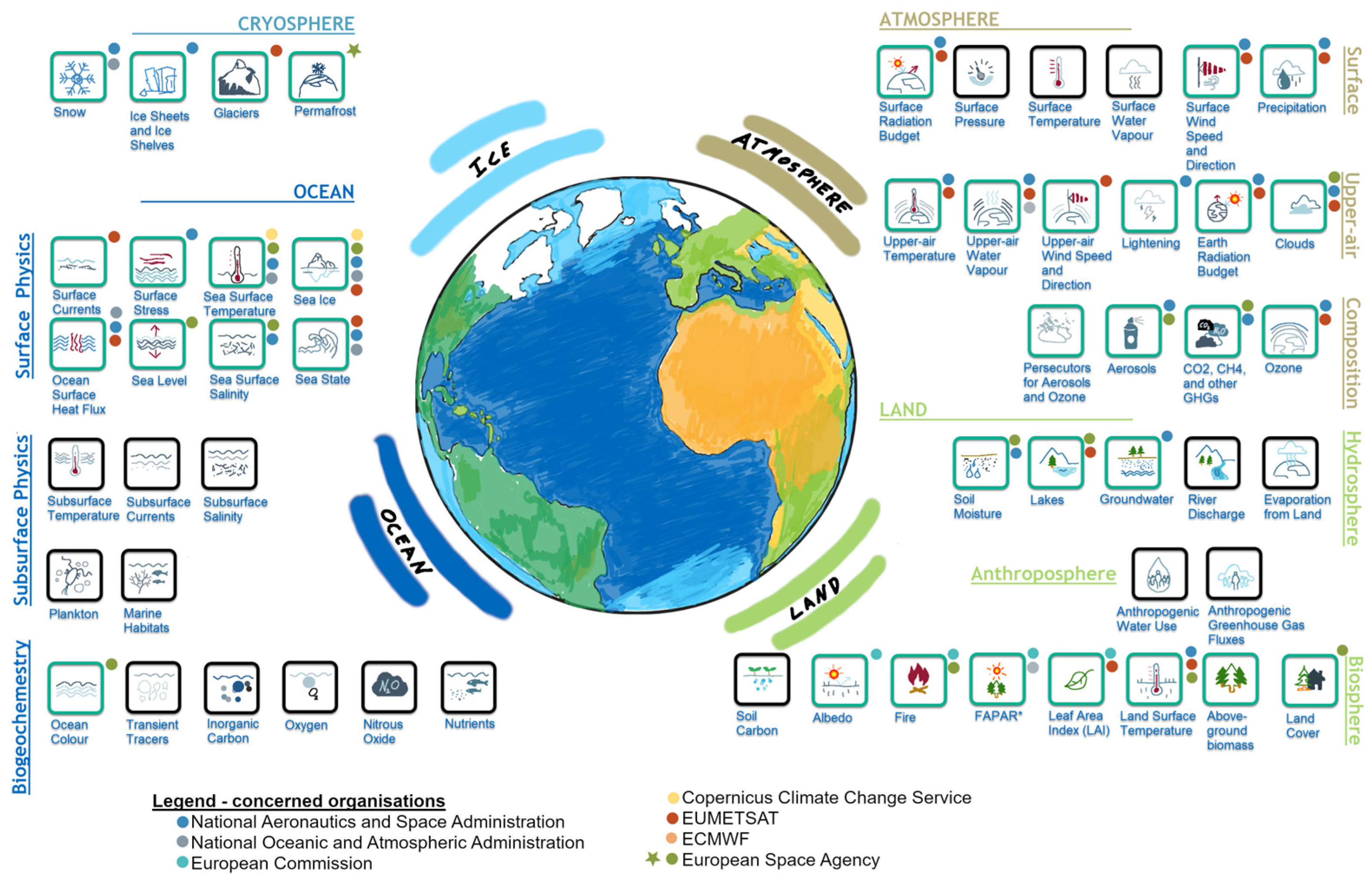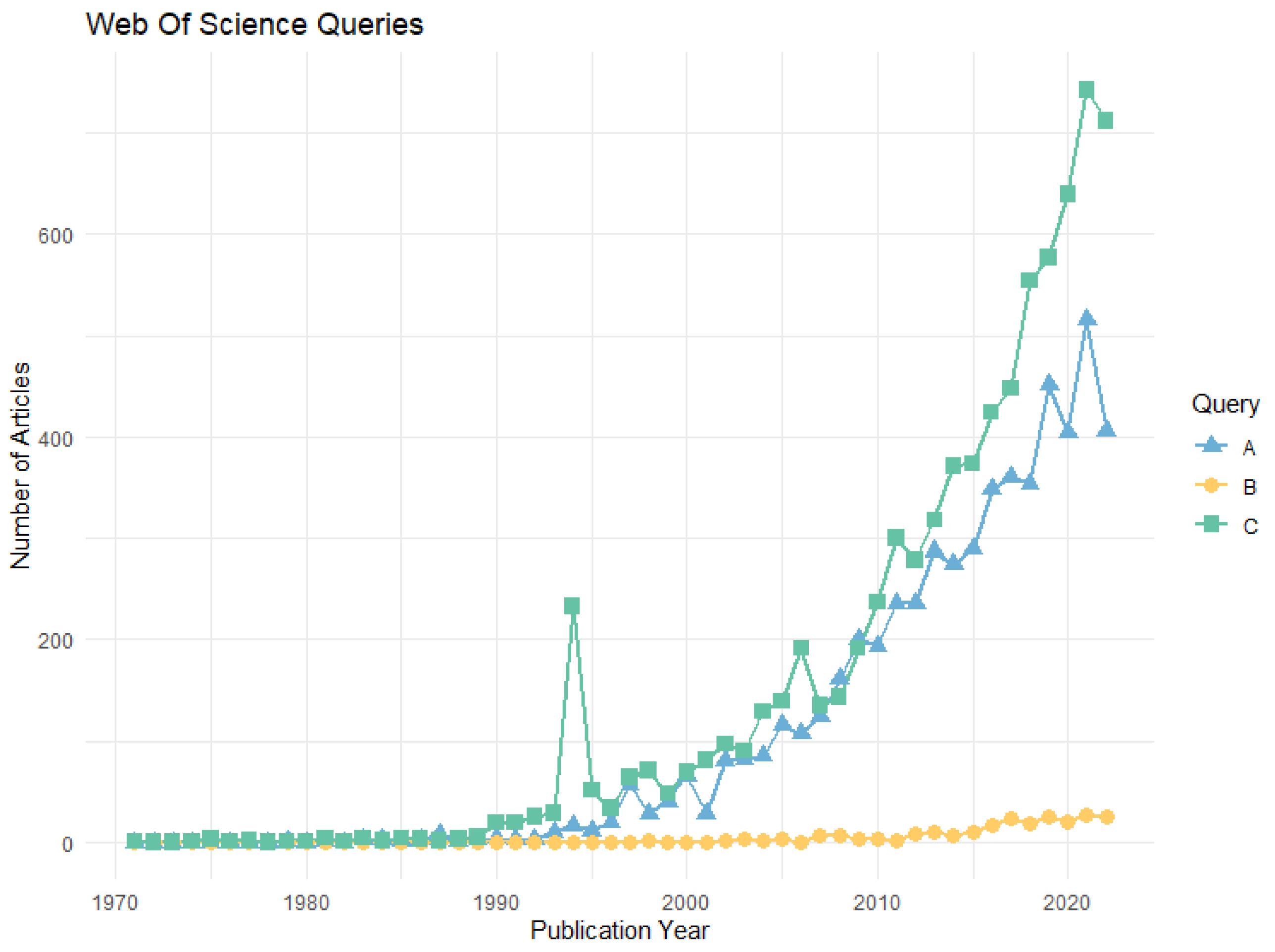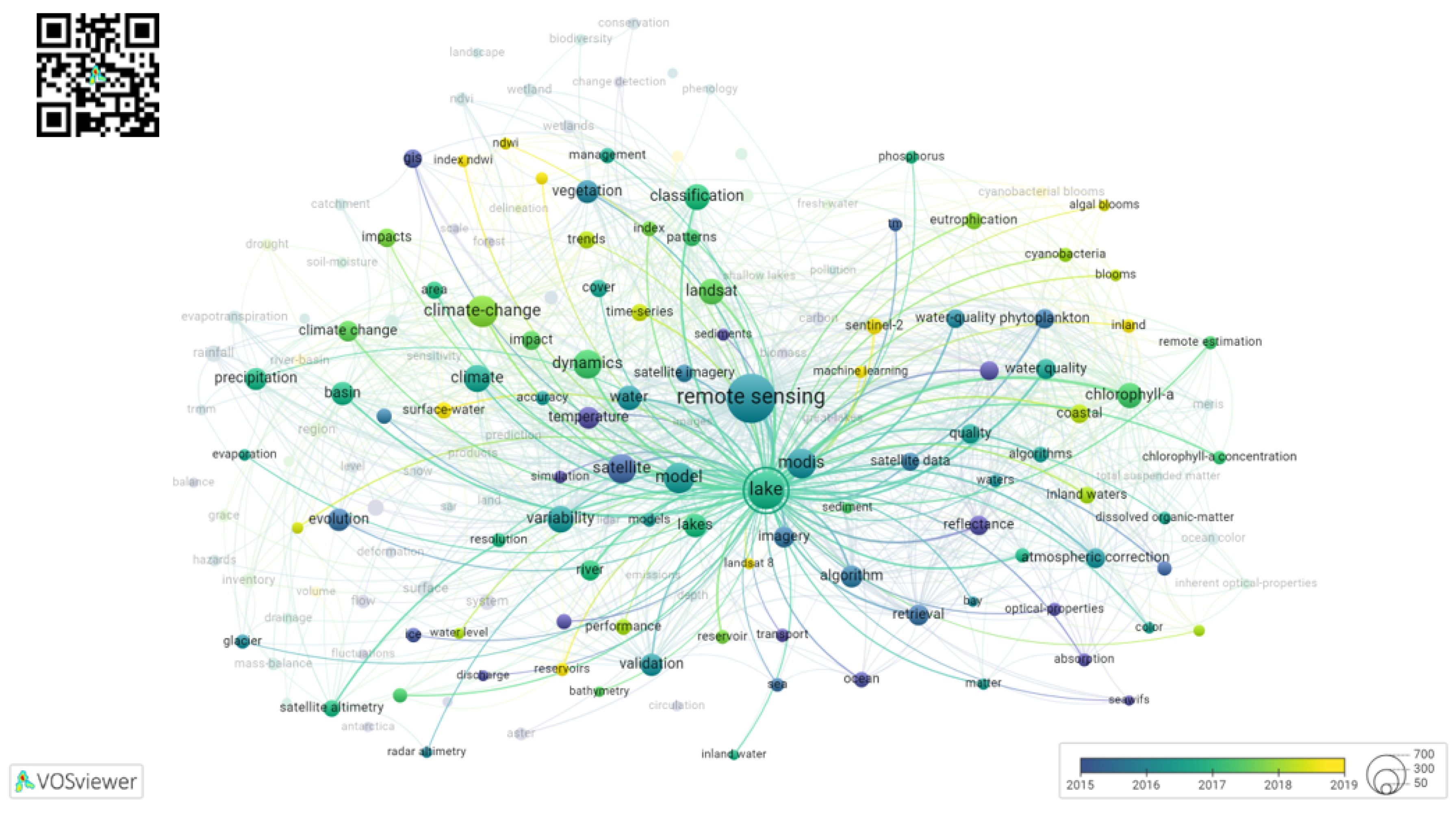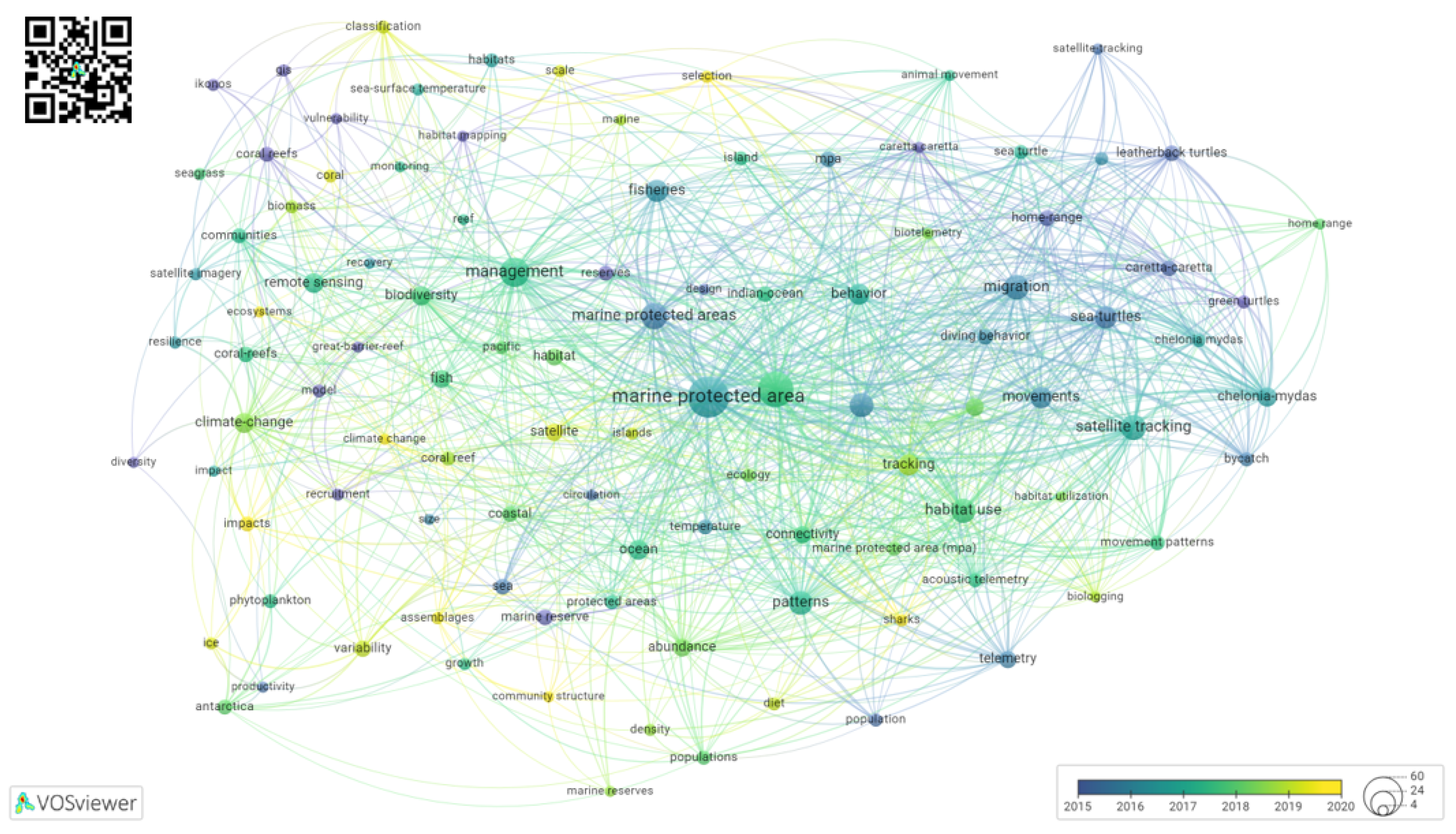Earth Observation—An Essential Tool towards Effective Aquatic Ecosystems’ Management under a Climate in Change
Abstract
1. Introduction
Monitoring Earth: From Oceans to Lakes and MAPs
2. Materials and Methods
3. Results on EO Policies and Decision-Making Structures
3.1. The EU Space Programme and Copernicus
“(Article 38) The Commission should work with data providers to agree licensing conditions for third-party data to facilitate their use within Copernicus, in compliance with this Regulation and applicable third-party rights. As some Copernicus data and Copernicus information, including high-resolution images, may have an impact on the security of the Union or Member States, in duly justified cases, measures in order to deal with risks and threats to the security of the Union or Member States may be adopted.”from EU Space Regulation (EU) 2021/696
3.2. Essential Climate Variables
4. Results and Analysis on the Current Scientific Demand of Satellite Data to MPAs and Lake Research
- Query A: Research on MPAs or marine reserves: ALL = (“marine protected area” OR “marine reserve”).
- Query B: The former applied to satellite data: ALL = ((“marine protected area” OR “marine reserve”) AND (“satellite data” OR “satellite” OR “Earth Observation”)).
- Query C: Lake research that already focused on the use of satellite data: ALL = (“lake” AND (“satellite data” OR “satellite” OR “Earth Observation”)).
5. Discussing Prospectives on the Feasibility of High- and Very High-Resolution Optical Satellites for Ocean and Lake Colour
6. Applications to Governance and Ecosystem-Based Management of the Cases Studied [Discussion]
6.1. Lakes and Inland Water Systems—A Much-Needed Variable for Ecosystem-Based Management
6.2. Marine Protected Areas
7. Conclusions: Changing Climate, Changing EO Needs
- (1)
- The maritime picture, being highly dynamic and constantly changing, is not subject to the same risks and threats posed by land imagery.
- (2)
- Creation of timeseries on water quality parameters could be specific to MPAs where military activities are in principle not foreseen.
- (3)
- Although the images themselves could still be protected by user rights, their scientific derived products do not need to be, especially considering these data are not sensitive.
Funding
Data Availability Statement
Acknowledgments
Conflicts of Interest
References
- Schellnhuber, H.J. ‘Earth System’ Analysis and the Second Copernican Revolution. Nature 1999, 402, C19–C23. [Google Scholar] [CrossRef]
- Calamita, E.; Lever, J.J.; Albergel, C.; Woolway, R.I.; Odermatt, D. Detecting Climate-Related Shifts in Lakes: A Review of the Use of Satellite Earth Observation. Limnol Ocean. 2024, 69, 723–741. [Google Scholar] [CrossRef]
- Field, C.B.; Behrenfeld, M.J.; Randerson, J.T.; Falkowski, P. Primary Production of the Biosphere: Integrating Terrestrial and Oceanic Components. Science 1998, 281, 237–240. [Google Scholar] [CrossRef] [PubMed]
- Dias, J.M.; Babanin, A.; Teresa De Castro Rodríguez, M.; Soldatenko, S. On the Effects of Mixed and Deep Ocean Layers on Climate Change and Variability. J. Mar. Sci. Eng. 2022, 10, 1216. [Google Scholar] [CrossRef]
- Soldatenko, S.A.; Yusupov, R.M. Sensitivity and Feedback Loops of a Zerodimensional Climate Model in the Context of the Weather and Earth’s Climate Control. SPIIRAS Proc. 2017, 3, 5–31. [Google Scholar] [CrossRef][Green Version]
- Pörtner, H.-O.; Roberts, D.C.; Masson-Delmotte, V.; Zhai, P.; Tignor, M.; Poloczanska, E.; Mintenbeck, K.; Alegría, A.; Nicolai, M.; Okem, A. IPCC, 2019: IPCC Special Report on the Ocean and Cryosphere in a Changing Climate. In The Ocean and Cryosphere in a Changing Climate; Cambridge University Press: Cambridge, UK, 2022. [Google Scholar]
- Schiermeier, Q. Climate Change: A Sea Change. Nature 2006, 439, 256–260. [Google Scholar] [CrossRef] [PubMed]
- Westberry, T.K.; Silsbe, G.M.; Behrenfeld, M.J. Gross and Net Primary Production in the Global Ocean: An Ocean Color Remote Sensing Perspective. Earth Sci. Rev. 2023, 237, 104322. [Google Scholar] [CrossRef]
- Irrgang, C.; Saynisch, J.; Thomas, M. Estimating Global Ocean Heat Content from Tidal Magnetic Satellite Observations. Sci. Rep. 2019, 9, 7839. [Google Scholar] [CrossRef] [PubMed]
- Maturi, E.M.; Shay, L.N.; Donahue, D.R.; Byrne, D.A. NOAA’s Operational Satellite Ocean Heat Content Products. J. Oper. Oceanogr. 2024, 17, 93–102. [Google Scholar] [CrossRef]
- Jayne, S.R.; Wahr, J.M.; Bryan, F.O. Observing Ocean Heat Content Using Satellite Gravity and Altimetry. J. Geophys. Res. Ocean. 2003, 108, 3031. [Google Scholar] [CrossRef]
- Smale, D.A.; Wernberg, T. Satellite-Derived SST Data as a Proxy for Water Temperature in Nearshore Benthic Ecology. Mar. Ecol. Prog. Ser. 2009, 387, 27–37. [Google Scholar] [CrossRef]
- Pace, M.L.; Prairie, Y.T. Respiration in Lakes. Respir. Aquat. Ecosyst. 2005, 1, 103–122. [Google Scholar] [CrossRef]
- Tranvik, L.J.; Downing, J.A.; Cotner, J.B.; Loiselle, S.A.; Striegl, R.G.; Ballatore, T.J.; Dillon, P.; Finlay, K.; Fortino, K.; Knoll, L.B.; et al. Lakes and Reservoirs as Regulators of Carbon Cycling and Climate. Limnol. Ocean. 2009, 54, 2298–2314. [Google Scholar] [CrossRef]
- Maeda, E.E.; Lisboa, F.; Kaikkonen, L.; Kallio, K.; Koponen, S.; Brotas, V.; Kuikka, S. Temporal Patterns of Phytoplankton Phenology across High Latitude Lakes Unveiled by Long-Term Time Series of Satellite Data. Remote Sens. Environ. 2019, 221, 609–620. [Google Scholar] [CrossRef]
- Pi, X.; Luo, Q.; Feng, L.; Xu, Y.; Tang, J.; Liang, X.; Ma, E.; Cheng, R.; Fensholt, R.; Brandt, M.; et al. Mapping Global Lake Dynamics Reveals the Emerging Roles of Small Lakes. Nat. Commun. 2022, 13, 5777. [Google Scholar] [CrossRef] [PubMed]
- Verpoorter, C.; Kutser, T.; Seekell, D.A.; Tranvik, L.J. A Global Inventory of Lakes Based on High-Resolution Satellite Imagery. Geophys. Res. Lett. 2014, 41, 6396–6402. [Google Scholar] [CrossRef]
- Holgerson, M.A.; Raymond, P.A. Large Contribution to Inland Water CO2 and CH4 Emissions from Very Small Ponds. Nat. Geosci. 2016, 9, 222–226. [Google Scholar] [CrossRef]
- Rouse, W.R.; Oswald, C.M.; Binyamin, J.; Blanken, P.D.; Schertzer, W.M.; Spence, C. Interannual and Seasonal Variability of the Surface Energy Balance and Temperature of Central Great Slave Lake. J. Hydrometeorol. 2003, 4, 720–730. [Google Scholar] [CrossRef]
- Notaro, M.; Holman, K.; Zarrin, A.; Fluck, E.; Vavrus, S.; Bennington, V. Influence of the Laurentian Great Lakes on Regional Climate. J. Clim. 2013, 26, 789–804. [Google Scholar] [CrossRef]
- Duarte, C.M.; Prairie, Y.T.; Montes, C.; Cole, J.J.; Striegl, R.; Melack, J.; Downing, J.A. CO2 Emissions from Saline Lakes: A Global Estimate of a Surprisingly Large Flux. J. Geophys. Res. Biogeosci. 2008, 113, 4041. [Google Scholar] [CrossRef]
- Downing, J.A.; Prairie, Y.T.; Cole, J.J.; Duarte, C.M.; Tranvik, L.J.; Striegl, R.G.; McDowell, W.H.; Kortelainen, P.; Caraco, N.F.; Melack, J.M.; et al. The Global Abundance and Size Distribution of Lakes, Ponds, and Impoundments. Limnol. Ocean. 2006, 51, 2388–2397. [Google Scholar] [CrossRef]
- Beck, R.; Zhan, S.; Liu, H.; Tong, S.; Yang, B.; Xu, M.; Ye, Z.; Huang, Y.; Shu, S.; Wu, Q.; et al. Comparison of Satellite Reflectance Algorithms for Estimating Chlorophyll-a in a Temperate Reservoir Using Coincident Hyperspectral Aircraft Imagery and Dense Coincident Surface Observations. Remote. Sens. Environ. 2016, 178, 15–30. [Google Scholar] [CrossRef]
- Boucher, J.; Weathers, K.C.; Norouzi, H.; Steele, B. Assessing the Effectiveness of Landsat 8 Chlorophyll a Retrieval Algorithms for Regional Freshwater Monitoring. Ecol. Appl. 2018, 28, 1044–1054. [Google Scholar] [CrossRef] [PubMed]
- Lisboa, F.; Brotas, V.; Santos, F.D.; Kuikka, S.; Kaikkonen, L.; Maeda, E.E. Spatial Variability and Detection Levels for Chlorophyll-a Estimates in High Latitude Lakes Using Landsat Imagery. Remote Sens. 2020, 12, 2898. [Google Scholar] [CrossRef]
- Searles Jones, J. To Solve Climate Change, Remember the Ocean. Nature 2019. [Google Scholar] [CrossRef] [PubMed]
- McLeod, E.; Chmura, G.L.; Bouillon, S.; Salm, R.; Björk, M.; Duarte, C.M.; Lovelock, C.E.; Schlesinger, W.H.; Silliman, B.R. A Blueprint for Blue Carbon: Toward an Improved Understanding of the Role of Vegetated Coastal Habitats in Sequestering CO2. Front. Ecol. Environ. 2011, 9, 552–560. [Google Scholar] [CrossRef] [PubMed]
- Donato, D.C.; Kauffman, J.B.; Murdiyarso, D.; Kurnianto, S.; Stidham, M.; Kanninen, M. Mangroves among the Most Carbon-Rich Forests in the Tropics. Nat. Geosci. 2011, 4, 293–297. [Google Scholar] [CrossRef]
- Pham, T.D.; Ha, N.T.; Saintilan, N.; Skidmore, A.; Phan, D.C.; Le, N.N.; Viet, H.L.; Takeuchi, W.; Friess, D.A. Advances in Earth Observation and Machine Learning for Quantifying Blue Carbon. Earth Sci. Rev. 2023, 243, 104501. [Google Scholar] [CrossRef]
- Halpern, B.S.; Lester, S.E.; McLeod, K.L. Placing Marine Protected Areas onto the Ecosystem-Based Management Seascape. Proc. Natl. Acad. Sci. USA 2010, 107, 18312–18317. [Google Scholar] [CrossRef]
- Hamel, M.A.; Andréfouët, S. Using Very High Resolution Remote Sensing for the Management of Coral Reef Fisheries: Review and Perspectives. Mar. Pollut. Bull. 2010, 60, 1397–1405. [Google Scholar] [CrossRef]
- van Eck, N.J.; Waltman, L. Software Survey: VOSviewer, a Computer Program for Bibliometric Mapping. Scientometrics 2010, 84, 523–538. [Google Scholar] [CrossRef] [PubMed]
- Harris, R.; Baumann, I. Open Data Policies and Satellite Earth Observation. Space Policy 2015, 32, 44–53. [Google Scholar] [CrossRef]
- Cubaynes, H.C.; Fretwell, P.T. Whales from Space Dataset, an Annotated Satellite Image Dataset of Whales for Training Machine Learning Models. Sci. Data 2022, 9, 245. [Google Scholar] [CrossRef] [PubMed]
- Mason, P.J.; Manton, M.; Harrison, D.E.; Belward, A.; Thomas, A.R.; Dawson, D.K. The Second Report on the Adequacy of the Global Observing Systems for Climate in Support of the UNFCCC; WMO: Geneva, Switzerland, 2003. [Google Scholar]
- Bojinski, S.; Verstraete, M.; Peterson, T.C.; Richter, C.; Simmons, A.; Zemp, M. The Concept of Essential Climate Variables in Support of Climate Research, Applications, and Policy. Bull. Am. Meteorol. Soc. 2014, 95, 1431–1443. [Google Scholar] [CrossRef]
- GHRSST Project Office; Beggs, H.; Karagali, I.; Castro, S. Sea Surface Temperature: An Introduction to Users on the Set of GHRSST Formatted Products; GHRSST Project Office: Copenhagen, Denmark, 2013. [Google Scholar] [CrossRef]
- GCOS-200. The Global Observing System for Climate Implementation Needs; World Meteorological Organization: Geneva, Switzerland, 2016. [Google Scholar]
- Groom, S.B.; Sathyendranath, S.; Ban, Y.; Bernard, S.; Brewin, B.; Brotas, V.; Brockmann, C.; Chauhan, P.; Choi, J.K.; Chuprin, A.; et al. Satellite Ocean Colour: Current Status and Future Perspective. Front Mar. Sci. 2019, 6, 485. [Google Scholar] [CrossRef]
- Veerman, J.; Kumar, A.; Mishra, D.R. Exceptional Landscape-Wide Cyanobacteria Bloom in Okavango Delta, Botswana in 2020 Coincided with a Mass Elephant Die-off Event. Harmful Algae 2022, 111, 102145. [Google Scholar] [CrossRef] [PubMed]
- Sayers, M.J.; Grimm, A.G.; Shuchman, R.A.; Bosse, K.R.; Fahnenstiel, G.L.; Ruberg, S.A.; Leshkevich, G.A. Satellite Monitoring of Harmful Algal Blooms in the Western Basin of Lake Erie: A 20-Year Time-Series. J. Great. Lakes. Res. 2019, 45, 508–521. [Google Scholar] [CrossRef]
- Osman, M.B.; Coats, S.; Das, S.B.; McConnell, J.R.; Chellman, N. North Atlantic Jet Stream Projections in the Context of the Past 1,250 Years. Proc. Natl. Acad. Sci. USA 2021, 118, e2104105118. [Google Scholar] [CrossRef] [PubMed]
- Ballari, D.; Vilches-Blázquez, L.M.; Orellana-Samaniego, M.L.; Salgado-Castillo, F.; Ochoa-Sánchez, A.E.; Graw, V.; Turini, N.; Bendix, J. Satellite Earth Observation for Essential Climate Variables Supporting Sustainable Development Goals: A Review on Applications. Remote Sens. 2023, 15, 2716. [Google Scholar] [CrossRef]
- Choi, K.T.H. Space, Satellite and Solutions: Essential Climate Variables and the Future of Climate Monitoring from Space. Weather 2018, 73, 390–391. [Google Scholar] [CrossRef]
- Catry, P.; Senhoury, C.; Sidina, E.; El Bar, N.; Bilal, A.S.; Ventura, F.; Godley, B.J.; Pires, A.J.; Regalla, A.; Patrício, A.R. Satellite Tracking and Field Assessment Highlight Major Foraging Site for Green Turtles in the Banc d’Arguin, Mauritania. Biol. Conserv. 2023, 277, 109823. [Google Scholar] [CrossRef]
- Eakin, C.M.; Nim, C.J.; Brainard, R.E.; Aubrecht, C.; Elvidge, C.; Gledhill, D.K.; Muller-Karger, F.; Mumby, P.J.; Skirving, W.J.; Strong, A.E.; et al. Monitoring Coral Reefs from Space. Oceanography 2010, 23, 118–133. [Google Scholar] [CrossRef]
- Rowlands, G.; Brown, J.; Soule, B.; Boluda, P.T.; Rogers, A.D. Satellite Surveillance of Fishing Vessel Activity in the Ascension Island Exclusive Economic Zone and Marine Protected Area. Mar. Policy 2019, 101, 39–50. [Google Scholar] [CrossRef]
- Appleby, T.; Studley, M.; Moorhouse, B.; Brown, J.; Staddon, C.; Bean, E. Sea of Possibilities: Old and New Uses of Remote Sensing Data for the Enforcement of the Ascension Island Marine Protected Area. Mar. Policy 2021, 127, 103184. [Google Scholar] [CrossRef]
- Toonen, H.M.; Bush, S.R. The Digital Frontiers of Fisheries Governance: Fish Attraction Devices, Drones and Satellites. J. Environ. Policy Plan. 2020, 22, 125–137. [Google Scholar] [CrossRef]
- O’Reilly, J.E.; Werdell, P.J. Chlorophyll Algorithms for Ocean Color Sensors—OC4, OC5 & OC6. Remote Sens. Environ. 2019, 229, 32–47. [Google Scholar] [CrossRef]
- Pahlevan, N.; Chittimalli, S.K.; Balasubramanian, S.V.; Vellucci, V. Sentinel-2/Landsat-8 Product Consistency and Implications for Monitoring Aquatic Systems. Remote Sens. Environ. 2019, 220, 19–29. [Google Scholar] [CrossRef]
- Mansaray, A.S.; Dzialowski, A.R.; Martin, M.E.; Wagner, K.L.; Gholizadeh, H.; Stoodley, S.H. Comparing PlanetScope to Landsat-8 and Sentinel-2 for Sensing Water Quality in Reservoirs in Agricultural Watersheds. Remote Sens. 2021, 13, 1847. [Google Scholar] [CrossRef]
- Chang, C.H.; Liu, C.C.; Wen, C.G.; Cheng, I.F.; Tam, C.K.; Huang, C.S. Monitoring Reservoir Water Quality with Formosat-2 High Spatiotemporal Imagery. J. Environ. Monit. 2009, 11, 1982–1992. [Google Scholar] [CrossRef] [PubMed]
- Liu, C.C.; Shieh, C.L.; Lin, J.C.; Wu, A.M. Classification of Non-Vegetated Areas Using Formosat-2 High Spatiotemporal Imagery: The Case of Tseng-Wen Reservoir Catchment Area (Taiwan). Int. J. Remote Sens. 2011, 32, 8519–8540. [Google Scholar] [CrossRef]
- IOCCG Earth Observations in Support of Global Water Quality Monitoring. IOCCG Report Series, No. 17, International Ocean Colour Coordinating Group, Dartmouth, Canada. Reports and Monographs of the International OceanColour Coordinating Group 2018. Available online: https://repository.oceanbestpractices.org/handle/11329/535 (accessed on 12 May 2024).
- Sakuno, Y.; Miño, E.R.; Nakai, S.; Mutsuda, H.; Okuda, T.; Nishijima, W.; Castro, R.; García, A.; Peña, R.; Rodríguez, M.; et al. Chlorophyll and Suspended Sediment Mapping to the Caribbean Sea from Rivers in the Capital City of the Dominican Republic Using ALOS AVNIR-2 Data. Environ. Monit. Assess. 2014, 186, 4181–4193. [Google Scholar] [CrossRef] [PubMed]
- Murakami, H.; Dupouy, C. Atmospheric Correction and Inherent Optical Property Estimation in the Southwest New Caledonia Lagoon Using AVNIR-2 High-Resolution Data. Appl. Opt. 2013, 52, 182–198. [Google Scholar] [CrossRef] [PubMed]
- Aoyama, T. Algorithm for Estimating the Chlorophyll-a Concentrations in Water Areas with Different Qualities from Satellite Data. Remote Sens. Coast. Ocean Land Atmos. Environ. 2010, 7858, 785819. [Google Scholar] [CrossRef]
- Pekel, J.-F.; Cottam, A.; Gorelick, N.; Belward, A.S. High-Resolution Mapping of Global Surface Water and Its Long-Term Changes. Nature 2016, 540, 418–422. [Google Scholar] [CrossRef] [PubMed]
- Coffer, M.M.A.; Schaeffer, B.A.; Urquhart, E.A.; Darling, J.A.; Salls, W.B. A Method for Quantifying the Number of U.S. Lakes with Cyanobacterial Harmful Algal Blooms Using Satellite Remote Sensing. In Remote Sensing and Modeling of Ecosystems for Sustainability XV; SPIE-International Society for Optics and Photonics: California, CA, USA, 2018; Volume 10767, pp. 60–72. [Google Scholar] [CrossRef]
- Kratzer, S.; Therese Harvey, E.; Philipson, P. The Use of Ocean Color Remote Sensing in Integrated Coastal Zone Management—A Case Study from Himmerfjärden, Sweden. Mar. Policy 2014, 43, 29–39. [Google Scholar] [CrossRef]
- Blasiak, R.; Yagi, N. Shaping an International Agreement on Marine Biodiversity beyond Areas of National Jurisdiction: Lessons from High Seas Fisheries. Mar. Policy 2016, 71, 210–216. [Google Scholar] [CrossRef]
- Delfour-Samama, O.; Leboeuf, C. Review of Potential Legal Frameworks for Effective Implementation and Enforcement of MPAs in the High Seas. ICES J. Mar. Sci. 2014, 71, 1031–1039. [Google Scholar] [CrossRef]
- Carr, H.; Abas, M.; Boutahar, L.; Caretti, O.N.; Chan, W.Y.; Chapman, A.S.A.; De Mendonça, S.N.; Engleman, A.; Ferrario, F.; Simmons, K.R.; et al. The Aichi Biodiversity Targets: Achievements for Marine Conservation and Priorities beyond 2020. PeerJ 2020, 8, e9743. [Google Scholar] [CrossRef]
- Home | Marine Protection Atlas. Available online: https://mpatlas.org/ (accessed on 15 May 2024).
- Tin, H.C.; Uyen, N.T.; Hieu, D.V.; Ni, T.N.K.; Tu, N.H.C.; Saizen, I. Decadal Dynamics and Challenges for Seagrass Beds Management in Cu Lao Cham Marine Protected Area, Central Vietnam. Environ. Dev. Sustain. 2020, 22, 7639–7660. [Google Scholar] [CrossRef]
- Prasetya, J.D.; Ambariyanto; Supriharyono; Purwanti, F. Diversity Based Sustainable Management for Seagrass Ecosystem: Assessing Distribution and Diversity of Seagrass in Marine Protected Area. Adv. Sci. Lett. 2017, 23, 2413–2415. [Google Scholar] [CrossRef]
- Zheng, H.; Ma, Y.; Huang, J.; Yang, J.; Su, D.; Yang, F.; Wang, X.H. Deriving Vertical Profiles of Chlorophyll-a Concentration in the Upper Layer of Seawaters Using ICESat-2 Photon-Counting Lidar. Opt. Express 2022, 30, 33320–33336. [Google Scholar] [CrossRef] [PubMed]






| Very High Resolution | High Resolution | Medium Resolution | Low Resolution | ||||
|---|---|---|---|---|---|---|---|
| VHR1 | VHR2 | HR1 | HR2 | MR1 | MR2 | LR | |
| resolution (R) | R ≤ 1 m | 1 < R ≤ 4 m | 4 < R ≤ 10 m | 10 < R ≤ 30 m | 30 < R ≤ 100 m | 100 < R ≤ 300 m | R > 300 m |
 “highly suitable”,
“highly suitable”,  “suitable” and
“suitable” and  “potential”. The symbol
“potential”. The symbol  refers to variables that in the original table were regarded has “potential” but some research made efforts that Chlorophyll-a can be inferred from Landsat systems [25].
refers to variables that in the original table were regarded has “potential” but some research made efforts that Chlorophyll-a can be inferred from Landsat systems [25].
 “highly suitable”,
“highly suitable”,  “suitable” and
“suitable” and  “potential”. The symbol
“potential”. The symbol  refers to variables that in the original table were regarded has “potential” but some research made efforts that Chlorophyll-a can be inferred from Landsat systems [25].
refers to variables that in the original table were regarded has “potential” but some research made efforts that Chlorophyll-a can be inferred from Landsat systems [25].| Resolution Class | Sensor/Satellite | Resolution (Pixel Size) | Number of Bands | Revisit Time | Data Cost | Launch Date | Water Quality Variables | Part of CCM? | References | |||||
|---|---|---|---|---|---|---|---|---|---|---|---|---|---|---|
| Chlorophyll-a | Cynobacterial Pigments | Total Suspended Matter | CDOM | Kd | Turbidity | |||||||||
| MR2 | Sentinel-3 OLCI | 300 m | 21 | daily | free | 2016 |  |  |  |  |  |  | Copernicus Space Segment | [39,55] |
| HR2 | Landsat 1–7 | 30 m | 4 | 16 days | free | Early July 1972 |  |  |  |  |  |  | No | [39,55] |
| HR2 | Hyperion | 30 m | 60 | 60 days | free | 2000 to 2017 |  |  |  |  |  |  | No | [39] |
| HR2 | Landsat 8 | 30 m | 5 | 16 days | free | September 2013 |  |  |  |  |  |  | No | Potential by [39,55] feasible by [25,40] |
| HR2 and MR1 (depending on the bands selected) | Sentinel-2 MSI | 10 m to 60 m bands | 10 | 5 days | free | June 2015 |  |  |  |  |  |  | Copernicus Space Segment | [39,55] |
| HR2 | KOMPSAT-2 | 1 m panchromatic 4 m multispectral | 4 | 5.5 days per satellite 1 day per constellation | paid | July 2006 |  |  |  |  |  |  | Yes | No models assessed, feasibility assessed by comparison with Landsat-5 |
| VHR1 and VHR2 | QuickBird, SPOT 6 and GeoEYE | 2–4 m | 3–4 | Programmable 60 days to 1 day | paid | After 1999 |  |  |  |  |  |  | No | Potential by [39] |
| HR1 | RapidEye | 6.5 m | 5 | Daily | paid | August 2008 |  |  |  |  |  |  | No | [39,55] |
| VHR2 | WordView-2 | 2 m spectral, 0.5 m panchromatic | 8 | Programmable 60 days to 1 day | paid | October 2009 |  |  |  |  |  |  | Yes | [39,55] |
| VHR1 | WorldView-3 | 0.5 m spectral | 8 | Programmable 60 days to 1 day | paid | 2016 |  |  |  |  |  |  | Yes | [39,55] |
| VHR2 | PlanetScope | 3 m | 8 | Daily | paid | 2016 |  |  |  |  |  |  | No | [52] |
| HR1 | Formosat-2 | 8 m multispectral, 2 m panchromatic | 4 | Daily | paid | May 2004 |  |  |  |  |  |  | No | [53,54] |
| HR1 | ALOS/AVNIR-2 | 10 m | 4 | Daily | free | April 2006 to April 2011 |  |  |  |  |  |  | No, but available through ESA | [56,57,58] |
Disclaimer/Publisher’s Note: The statements, opinions and data contained in all publications are solely those of the individual author(s) and contributor(s) and not of MDPI and/or the editor(s). MDPI and/or the editor(s) disclaim responsibility for any injury to people or property resulting from any ideas, methods, instructions or products referred to in the content. |
© 2024 by the authors. Licensee MDPI, Basel, Switzerland. This article is an open access article distributed under the terms and conditions of the Creative Commons Attribution (CC BY) license (https://creativecommons.org/licenses/by/4.0/).
Share and Cite
Lisboa, F.; Brotas, V.; Santos, F.D. Earth Observation—An Essential Tool towards Effective Aquatic Ecosystems’ Management under a Climate in Change. Remote Sens. 2024, 16, 2597. https://doi.org/10.3390/rs16142597
Lisboa F, Brotas V, Santos FD. Earth Observation—An Essential Tool towards Effective Aquatic Ecosystems’ Management under a Climate in Change. Remote Sensing. 2024; 16(14):2597. https://doi.org/10.3390/rs16142597
Chicago/Turabian StyleLisboa, Filipe, Vanda Brotas, and Filipe Duarte Santos. 2024. "Earth Observation—An Essential Tool towards Effective Aquatic Ecosystems’ Management under a Climate in Change" Remote Sensing 16, no. 14: 2597. https://doi.org/10.3390/rs16142597
APA StyleLisboa, F., Brotas, V., & Santos, F. D. (2024). Earth Observation—An Essential Tool towards Effective Aquatic Ecosystems’ Management under a Climate in Change. Remote Sensing, 16(14), 2597. https://doi.org/10.3390/rs16142597




